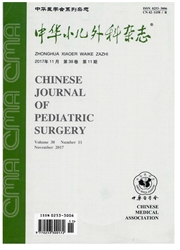

 中文摘要:
中文摘要:
目的探究以MyD88为关键传导分子的TLR4下游炎症-凋亡信号通路在NEC发病过程中的作用机制。方法采用SPF级,新生10日龄MyD88^-/-幼鼠和相应的野生型幼鼠,共32只,分别按照数字表法随机分配进入NEC实验组或对照组;NEC实验组幼鼠置入自制新生保育箱内造模处理(每日人工配置鼠乳代用品喂养,5次/d;每次给予N2缺氧90S后,快速充入O2复氧,再次置入4℃环境冷刺激10min,3次/d,连续3d;LPS10mg/kg稀释于0.1ml灭菌水中,去芯留置针头口腔插管灌胃,1次/d,连续3d);对照组继续与母鼠同笼,鼠乳喂养。实验结束后取材回肠末端肠管组织,HE染色法组织病理评分及液相芯片细胞因子TNF-α及IL-1β检测判断各组肠道NEC炎症程度。TUNEL方法检测各组小鼠肠道细胞的凋亡水平变化。实时荧光定量逆转录聚合酶链反应(reverse transcription-polymerase chain reaction,RT-PCR)检测各组小肠组织内TLR4炎症-凋亡通路中TRIF、IRF-3、NF-κb、Bax、Bcl-2、Caspases的mRNA表达情况。结果与野生鼠NEC组相比,MyD88敲除鼠小肠炎症程度评分(1.63±0.52比2.75±0.46)、炎症效应分子NF_小表达(1.38±0.25比2.33±0.76)、促炎因子IL-1β(465.57±81.59比863.58±198.28)、TNF-α(5.41±0.83比6.48±1.15)水平明显降低;肠上皮细胞凋亡明显减少(4.44±0.47比9.75±1.00),凋亡效应分子Caspases 8(2.03±0.20比4.06±0.44)、Caspases 9(1.02±0.08比1.93±0.09)、Caspases 3(1.87±0.28比6.75±1.12)和促凋亡基因Bax(1.15±0.25比2.40±0.42)表达降低(P〈0.05)。MyD88非依赖通路中关键因子TRIF(1.85±0.38比1.4±0.19)和IRF-3(2.01±0.41比1.53±0.38)表达上调(P〈0.05);抗凋亡基因Bcl-2(1.18±0.31比1.10±0.20)表达无变化(P〉0.05)。结论①TLR4下游的MyD88-NF-κb信号通路是NE
 英文摘要:
英文摘要:
Objective To explore the effects of myeloid differentiation protein 88 (MyD88) in TLR4 downstream inflammation-apoptosis signaling on inflammatory severity in the development of necrotizing enterocolitis (NEC). Methods Thirty-two SPF (specific pathogen-free) newborn (10-day- old), 16 MyD88-deficient (MyD88-/-) and 16 MyD88 wild-type (MyD88-WT) (C57BL/6j) mice were selected and randomly divided into control and NEC groups. Each group was further divided into two equal subgroups of MyD88-Ko and MyD88-WT. NEC was induced in a self-made incubator (formula feeding, 5 times/day; hypoxia for 90 sec, rapid reoxygenation, 4 ℃ for 10 min, thrice daily;lipopolysaccharide 10 mg/kg into 0. 1 ml water, tubular indwelling needle in stomach, once daily, 3 consecutive days). The control newborn mice remained breast-fed. The NEC severity of terminal ileum tissue was evaluated by histopathologic grading system with hematoxylin & eosin staining and the levels of tumor necrosis factor-alpha (TNF-α) and interleukin-1β (IL-1β) were detected with liquid chip. Enterocytic apoptosis was evaluated by terminal deoxynucleotidyl transferase mediated dUTP nick-end labeling (TUNEL). Inflammatory or apoptotic molecules including NF-eB, TRIF, IRF-3, Bax, Bcl-2 and caspases were examined by quantitative reverse transcription-polymerase chain reaction (qRT-PCR). Results Compared with wide-type NEC group, NEC severity (1.63±0. 52 vs 2. 75±0. 46) and the levels of IL-1β (465.57 ± 81.59 vs 863.58 ±198. 28) and TNF-α (5.41 ± 0. 83 vs 6. 48 ± 1.15) all decreased in MyD88-Ko group. The apoptotic rate of intestinal enteroeytes (4. 44 ±0. 47 vs 9. 75 ± 1.00) declined (P〈0. 05). And the expressions of NF-κb (1.38±0. 25 vs 2. 33 ± 0. 76), easpase 8 (2. 03±0. 20 vs 4. 06 ±0. 44), caspase 9 (1.02 ± 0. 08 vs 1.93± 0. 09), caspase 3 (1.87 ±0. 28 vs 6. 75 ± 1.12) and Bax (1.15 ± 0. 25 vs 2. 40 ± 0. 42) were all down-regulated (P〈0. 05) while
 同期刊论文项目
同期刊论文项目
 同项目期刊论文
同项目期刊论文
 Downregulation of GRP78 and XIAP is correlated with apoptosis during cerulein-induced acute pancreat
Downregulation of GRP78 and XIAP is correlated with apoptosis during cerulein-induced acute pancreat Traditional Chinese medicine in the treatment of pediatric acute pancreatitis: West China hospital&a
Traditional Chinese medicine in the treatment of pediatric acute pancreatitis: West China hospital&a Wnt Inhibitory Factor-1 functions as a tumor suppressor through modulating Wnt/β-catenin signaling i
Wnt Inhibitory Factor-1 functions as a tumor suppressor through modulating Wnt/β-catenin signaling i Resolvin D1 protects againstinflammation in experimental acute pancreatitis and associated lung inju
Resolvin D1 protects againstinflammation in experimental acute pancreatitis and associated lung inju 期刊信息
期刊信息
